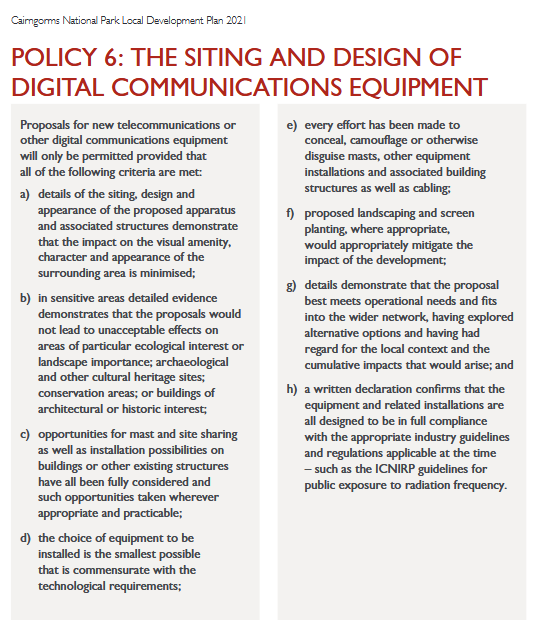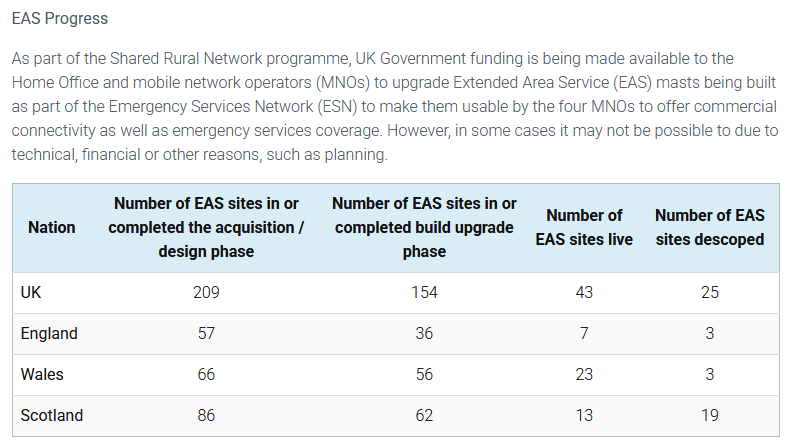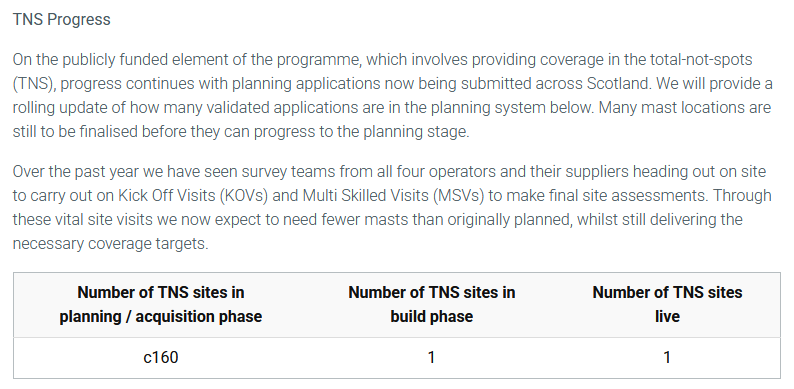In November David Craig explained how advances in smart phone technology meant that any masts erected under the UK Government’s Shared Rural Network programme to eliminate Total Not Spots would soon become obsolete (see here). On 25th March Ofcom issued a set of proposals for consultation which would remove the regulatory block to that happening by allowing “mobile networks and satellite operators to use mobile airwaves – called radio spectrum – to connect mainstream handsets in the UK” (see here). Ofcom’s news release states that it could potentially authorise such services to go ahead before the end of this year.
Ofcom confirms the analysis provided by David Craig and others on Parkswatch:
“Previously, mobile satellite services from space have mainly been available to a niche group of users – for example, on ships and aircraft – with specialist handsets that can be expensive. If this was more widely available, it would help connect the UK’s most rural and hard-to-reach places. This could mean getting a signal in remote villages and up mountains, and could provide vital back-up options during outages.”
Interestingly the news release reports that:
“In January, Vodafone successfully made the world’s first satellite video call using a standard mobile phone, up a mountain in west Wales where there was no coverage. This was made possible by Ofcom issuing an innovation and trial licence”. [This was with a company called AST SpaceMobile].
There is no mention of the Shared Rural Network programme in Ofcom’s news release. Ofcom’s announcement has, however, made the original plan to reduce Total Not Spots in mobile phone coverage to a maximum of 95% of the UK landmass by paying £500m to mobile operators to erect masts in remote areas completely redundant. Satellite technology will provide 100% coverage and to the seas around Scotland too.
Satellites also provide mobile coverage without any impact on the landscape, removing the need for the masts themselves and their associated access roads, and reduces the wider environmental impacts resulting from their construction and servicing (including the back-up diesel generators needed to power them).
Satellite technology also has implications for the Shared Rural Network programme to eliminate Partial Not Spots which is being paid for by the mobile operators. While sharing existing masts is likely to be the most cost effective option for the foreseeable future, whether they are likely to continue to erect new masts, such as that approved at Creagh Dhubh on appeal (see here), will depend on the cost of satellite services. While Elon Musk’s Starlink is currently the market leader, as the Telegraph explained following Ofcom’s announcement (see here) “it is facing growing competition from Eutelsat OneWeb, the French satellite company in which the UK Government has a stake, as well as Amazon’s Kuiper system”. That should help bring prices down and is likely to make even more masts redundant.
Planning policy and mobile-satellite technology
It is not uncommon for planning and other government policy to lag technological developments. The rapid developments in mobile-satellite technology mean that the policies which planning authorities have used to determine applications for new telecommunications masts are now out of date and no longer fit for purpose. For example, the policies of both the Cairngorms and Loch Lomond and National Park Authorities are based on the assumption that masts – referred to as telecommunications structures or equipment in their Local Development Plans – are needed to improve mobile coverage:

This policy is all about the micro-siting and design of masts in the National Park NOT about whether they are needed in the first place – which is why the CNPA failed to call-in the application for a mast at Creag Dhubh (see here).
While planning authorities still have to consider their local policies on masts for every planning application, they are overridden by Policy 24 on Digital Infrastructure in the Scottish Government’s National Planning Framework 4 where it says anything different. Policy 24 was also adopted before the developments in mobile-satellite connectivity and also creates a policy presumption in favour of developments (i.e physical structures like masts) that improve digital infrastructure, particularly in rural areas. This has been used to justify the erection of new telecommunications masts.
However, only one paragraph (e) (ii) in Policy 24 actually refers to masts:
“e) Development proposals for digital infrastructure will only be supported where:
i. the visual and amenity impacts of the proposed development have been minimised through careful siting, design, height, materials and, landscaping, taking into account cumulative impacts and relevant technical constraints;
ii. it has been demonstrated that, before erecting a new ground based mast, the possibility of erecting antennas on an existing building, mast or other structure, replacing an existing mast and/or site sharing has been explored; and
iii. there is no physical obstruction to aerodrome operations, technical sites, or existing transmitter/receiver facilities.”
Arguably the implication of sub-paragraph ii) is that if there is an alternative to erecting a new mast then that should be used.
Unfortunately, neither the Scottish Government nor our National Park Authorities have so far been brave enough to say the developments in mobile-satellite technology mean that should is now the preferred option and that instead of a planning presumption in favour of new masts they should only be considered in exceptional circumstances.
Other grounds in NPF4 for Planning Authorities to refuse planning applications for new masts are provided by paragraph a):
“Development proposals that incorporate appropriate, universal, and future-proofed digital infrastructure will be supported”.
Clearly masts in remote areas are not future proofed and have had their day.
The problem of redundant masts
A related planning issue is what is going to happen to the hundreds of masts across the UK, including those erected under the Shared Rural Network programme, when they are abandoned by operators as financially cheaper options emerge?
While most of the decisions approving new masts require the applicant to restore the site should the mast no longer used, enforcing that is another matter. The cost of removing masts in remote areas is significant and there is always the possibility of redundant mast sites being transferred to another company which then conveniently goes bust. Given these risks, where any new mast is now approved, whether in a Total Not Spot or not, it should be on condition the applicant takes out a bond guaranteeing the site will be restored.
To date progress on the Extended Area Service element of the Shared Rural Network programme, under which the UK Government is paying for new masts for the emergency services but then allowing the mobile operators to use them, has been much more rapid than misguided attempt to eliminate Total Not Spots ((TNS). There are 43 new EAS sites live and 154 in the build phase:

That compares to one TNS site live and one in the pipeline:

While the first TNS site to go live – on South Uist – was greeted with great fanfare (see here) it was only in November. Moreover it has now been reported (see here) that £184m from the TNS programme has now been diverted to the EAS programme whose primary purpose is to improve mobile connectivity used by the the emergency services (i.e generally close to roads). That appears to be an indication that both the UK Government and the mobile operators know that advances in technology are rapidly making the TNS element of the SRN programme redundant. At the very least it will cut the number of potential masts in Total Not Spots by a third.
There are, however, still a significant number of planning applications that have been approved but where building work has been started. The risk is that with the UK Government picking up the tab – there was nothing in Rachel Reeves Spring Statement speech to say they were now going to end the TNS programme entirely (see here) – some of these sites still go ahead.
Planning chaos
While the TNS programme no longer makes any sense, it is not in the financial interests of the companies contracted by the mobile operators to plan and build new masts to suspend activity. Indeed the more applications that are approved, the more sites purchased and the more construction projects started the higher the profits or the compensation they are likely to receive when the programme is terminated.
This helps explain the number of mast applications still being documented by the SRN Mast Action Group on their excellent Facebook Page (see here). The information there also suggests that planning authorities are in complete chaos when it comes to deciding what to do about mast applications: approving some; rejecting others; and, in many cases sitting on the fence for months – no doubt in the hope that the Scottish Government might issue updated guidance.
To illustrate the issues there are currently six planning applications for masts being considered by the Loch Lomond and Trossachs National Park Authority (LLTNPA), one in a remote area but the other five all in areas of significant landscape importance:
| Reference | Location | Date of application |
| 2024/0027/DET | Land North of Loch Sloy | 14th Feb 2024 |
| 2024/0137/DET | Glen Finglas | 3rd June 2024 |
| 2024/0149/DET | Glen Kinglas | 4th July 2024 |
| 2024/0155/DET | Inverlochlarig, Balquidder | 8th July 2024 |
| 2024/0232/DET | Glen Ogle | 30th August 2024 |
| 2024/0339/DET | Leny Feus, Callander | 21st Feb 2025 |
I have lodged an objection to the Loch Sloy application (see here) – a remote area albeit blighted by conifer plantations – that there is now no justification for erecting a mast in this area. Worryingly the statement from the developer about their pre-application discussions with the LLTNPA states:
“We received a detailed written response on 08 January 2024 confirming that new digital infrastructure is generally supported and the principle of development would be assessed against Telecommunications Policy 1 of the LDP and Policy 24 of NPF4.”
The telecommunications policy from the LLTNPA’s Local Development Plan (like most of their other policies) is now totally out of date (the plan dates from 2017). Because of this I have asked that this application should NOT be decided by officers, as usually happens in the Park, but referred to the planning committee for consideration in the light of Ofcom’s announcement.
In my view both the LLTNPA and CNPA could and should be showing a lead here by issuing supplementary advice to would-be mast developers about how they will respond to planning applications in the light of the developments in mobile-satellite technology. I have made a number of representations to the CNPA about this (the LLTNPA refuse to communicate with me) but sadly they have chosen so far to keep quiet rather than promote the public interest.
It is no wonder so many people in Scotland are now disillusioned with Scotland’s National Parks. If they cannot even do a simple thing like state “developments in mobile-satellite technology have removed any justification for agreeing to telecommunications masts in Scotland’s most beautiful and remote areas” there is no point having them. Unfortunately the Scottish Government, which should be commissioning an independent review into why Scotland’s National Parks have failed so badly and fixing those problems before creating any new ones, is the root cause of the problem.

Up here in Highland, we are still getting SRN applications at the rate of a couple per month and one recent one in a WLA was very much ignoring what’s been happening in the political world. Highland council have also recently approved a classic nonsensical SRN mast in a WLA. The fight continues….
Totally agree. Highland North Planning Committee is particularly bad at waving applications through. The area east of Incheril is set to get yet another redundant blot on its landscape, approved this week, thanks to them. Trouble is, landscape counts for relatively little in planners’ evaluations and the response from the general public is a shrug of apathy on repeat. Even when locals object in large numbers, they are often ignored.
two recent calls to emergency services in the highlands were from Total Not Spots. The first was someone with a Personal Locator Beacon and the second by someone using a mobile phone’s SOS function. Both link to satellites in emergencies, just like a GPS.
Update; Vodaphone planning to offer satellite enabled, low data rate calls in the UK from 2026:
[Press release] “Vodafone is spearheading the introduction of commercial direct-to-smartphone mobile broadband satellite connectivity across Europe later in 2025 and 2026.
Vodafone and its partners see satellite connectivity as a complementary, bolt-on technology providing valuable coverage and resilience where no feasible mobile or fixed alternative exists at present such as on mountains or out at sea.”
https://www.vodafone.com/news/technology/vodafone-ast-space-mobile-and-university-of-malaga-launch-new-space-and-land-mobile-broadband-research-and-validation-hub-for-europe
[Trade Journal article] “This is essentially a space-based 2G, 4G and 5G mobile broadband service that can connect with regular handsets around the world.
The eventual aim is to make this service attractive for regular consumers (we suspect this may form part of a ‘global roaming’ style add-on for mobile plans, at extra cost). Today’s agreement thus establishes the framework for Vodafone to offer space-based cellular broadband connectivity in its home markets (e.g. the UK),”
https://www.ispreview.co.uk/index.php/2024/12/ast-space-mobile-and-vodafone-sign-long-term-5g-satellite-deal.html